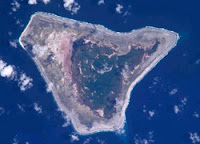
As you get close to Ramona, heading north California on State 67, you’ll pass a landscaped hill and driveway on your right. There’s a big sign on the hill, saying simply “Lemurian Fellowship”. I’ve passed that sign many times, and wondered just what it could be referring to.
Now, thanks to a little googling, I know the answer.
My first thought (this being California) is that it was some kind of society dedicated to friendly relations between mankind and lemurs. Perhaps too friendly, in a NAMBLA sort of way, so I was a little afraid to go there. But, thankfully, the Lemurian Fellowship has nothing whatsoever to do with lemurs, or unnaturally friendly relations with them.
Whew!
But as I explored in more detail what the Lemurian Fellowship was really all about, I wasn’t greatly comforted. It turns out that the Lemurian Fellowship is a cult religion/philosophy, with their core belief being that a superior human civilization existed until about 26,000 years ago, when the continent they lived on ("Mu", also called “Lemuria") sank into the Pacific Ocean. The map at upper right is allegedly a map of this lost continent.
From the Lemurian Fellowship's pamphlet “Into the Sun":
THE FIRST AND GREATEST CIVILIZATION
At one time in human history, there was a civilization where people enjoyed a peace of mind not possible in today’s world. Its population understood and lived by divine law, personally and nationally, enabling them to build the most magnificent civilization the world has known, which flourished for fifty thousand years.
The first human society was organized 78,000 years ago on the Continent of Mu (Lemuria), which once covered most of what is now the Pacific Ocean. The civilization began when a few outstanding individuals of above average mental ability realized the possibilities of a better way of life. Through close observation, practice, and divine assistance, they gradually acquired an understanding of universal law, becoming known as Elders. Gathering other deeper thinkers, they took the first steps toward social unity by teaching those who joined this effort to live cooperatively in conformance with God’s laws.
Within an incredibly short time, the Lemurian or Mukulian Empire developed, prosperous and at peace with all. Growing into a benign and cooperative power, it eventually achieved cultural and material accomplishments which would seem impossible today. But a fatal mistake was made. As the civilization grew, untrained helpers were brought in to perform manual labor. Gradually this proletarian element increased, while the citizenry shrank because few were being trained to become citizens. Eventually, the proletariat began taking over, administering the government according to their own ideas. The great Empire began to decline, and around 24,000 B.C., after cataclysmic upheavals, the continent sank beneath the waves of the Pacific.
As usual in such a cult, not a shred of what most people would consider “evidence” is presented to support their fundamental beliefs. For example, in the section of the pamphlet dedicated to persuading you that Mu actually existed, you’ll find this:
Consider Malden Island in the central Pacific. Uninhabited when discovered in 1798, Malden was waterless, barren, uninhabitable. Yet it contained remnants of forty massive stone temples. Radiating from the temples in every direction are highways paved with basalt blocks – highways leading into the Pacific Ocean! Where did these highways go originally? By whom and for whom were they built?
Jane Resture’s authoritative Oceania site has a slightly different take (NASA satellite photo of Malden Island at right):
There is abundant evidence to show that Polynesians lived on Malden before its discovery by white men. Earliest explorers reported stone-faced platforms and graves. Several descriptions have been given of these, together with speculations as to when and by whom they were built.
The late Dr. J. Macmillan Brown draws a highly imaginative picture of “great temple pyramids” dating from a time when Malden formed part of a “vanquished empire,” and people coming on pilgrimages to it from “fertile archipelagos within canoe distance of its shores,” which now have sunk. Kenneth P. Emory, Bishop Museum anthropologist, who studied the ruins in 1924, has published an account which agrees not at all with these fantastic ideas. The stone structures are located around the beach ridges, principally on the north and south. They include temple platforms, called marae, house sites, and graves. They indicate that Polynesians lived on Malden for several generations, and that this was not many centuries ago. Comparisons with stone structures on Tuamotu atolls show that a population of between 100 and 200 natives could have produced all of the Malden structures. Maraes of a similar type are found on Ra’ivavae, one of the Austral Islands. The natives got their water from wells, remains of which have been found, always dry or salty at present.
At least they don’t appear to have a proclivity to violence, like the radical Islamic fundamentalists; I take some small comfort from that.
But … they walk among us…

In the old blog, chrys said:
ReplyDeleteHmm - Guess that’s how all of the Pacific island nations became populated?! Something happened, some time. Guess we’ll never know if it’s invented or true. Hey - I wasn’t there 78,000 years ago. Certainly would put a crimp in the idea of evolution. ;-)
In the old blog, Anonymous said:
ReplyDeleteI too am glad to find that they have nothing to do with unnatural relations with Lemurs- kinda wondered as I now live up in Ramona.